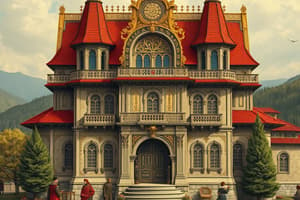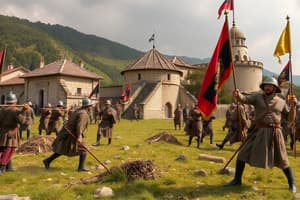Podcast
Questions and Answers
What year did the Ottoman Empire conquer Bosnia-Herzegovina?
What year did the Ottoman Empire conquer Bosnia-Herzegovina?
- 1908
- 1878
- 1459
- 1463 (correct)
The Serbs converted to Roman Catholicism during the 9th Century.
The Serbs converted to Roman Catholicism during the 9th Century.
False (B)
What was the significance of the assassination of Archduke Ferdinand in 1914?
What was the significance of the assassination of Archduke Ferdinand in 1914?
It marked the beginning of World War I.
The _______ Empire ruled the region from 1459 to 1878, significantly impacting the rights of the Serbs.
The _______ Empire ruled the region from 1459 to 1878, significantly impacting the rights of the Serbs.
Match the following groups with their primary religious affiliations:
Match the following groups with their primary religious affiliations:
Which country was established to unify the Balkans under one government?
Which country was established to unify the Balkans under one government?
Serbia had no role in the governance of Yugoslavia.
Serbia had no role in the governance of Yugoslavia.
What was the political and ethnic strategy implemented by Tito in Yugoslavia?
What was the political and ethnic strategy implemented by Tito in Yugoslavia?
After the fall of the Soviet Union in 1989, Yugoslavia _______.
After the fall of the Soviet Union in 1989, Yugoslavia _______.
Who took power in Serbia in 1986 and is associated with the rise of Serbian nationalism?
Who took power in Serbia in 1986 and is associated with the rise of Serbian nationalism?
Match the following countries with their predominant religions:
Match the following countries with their predominant religions:
The rise of Serbian nationalism in the 1990s was characterized by a desire for reconciliation with Bosnian Muslims.
The rise of Serbian nationalism in the 1990s was characterized by a desire for reconciliation with Bosnian Muslims.
What narrative did Serbian nationalism adopt regarding Bosnian Muslims during the conflicts in the 1990s?
What narrative did Serbian nationalism adopt regarding Bosnian Muslims during the conflicts in the 1990s?
What is one of the consequences for children born from rape, according to the content?
What is one of the consequences for children born from rape, according to the content?
The stigma of rape can lead to children being referred to as 'marked children'.
The stigma of rape can lead to children being referred to as 'marked children'.
Name the two main ethnic groups involved in the Rwandan genocide.
Name the two main ethnic groups involved in the Rwandan genocide.
Rwanda is bordered by _____, Uganda and Tanzania.
Rwanda is bordered by _____, Uganda and Tanzania.
Match the colonial practices with their purposes:
Match the colonial practices with their purposes:
Which of the following was a common perception during colonization regarding the Bantu tribes?
Which of the following was a common perception during colonization regarding the Bantu tribes?
Hutus were generally more affluent than Tutsis.
Hutus were generally more affluent than Tutsis.
During colonization, women were often controlled through _____ and violence.
During colonization, women were often controlled through _____ and violence.
Which of the following was NOT a characteristic of the Tutsi according to anti-Tutsis propaganda?
Which of the following was NOT a characteristic of the Tutsi according to anti-Tutsis propaganda?
The Hutu were seen as the privileged group during the German colonialism.
The Hutu were seen as the privileged group during the German colonialism.
What was the name of the hate radio that spread propaganda against Tutsis?
What was the name of the hate radio that spread propaganda against Tutsis?
The anti-Tutsi propaganda described Tutsis as __________, drawing parallels to pests that threatened crops.
The anti-Tutsi propaganda described Tutsis as __________, drawing parallels to pests that threatened crops.
Match the following sources of propaganda with their descriptions:
Match the following sources of propaganda with their descriptions:
What event triggered the 1994 genocide against the Tutsi?
What event triggered the 1994 genocide against the Tutsi?
What percentage of babies born from rape victims in Rwanda were abandoned?
What percentage of babies born from rape victims in Rwanda were abandoned?
Children born of rape in Rwanda were generally accepted by Tutsi society regardless of their mother's status.
Children born of rape in Rwanda were generally accepted by Tutsi society regardless of their mother's status.
All Tutsi, including women and children, were targeted for extermination in a hierarchical manner.
All Tutsi, including women and children, were targeted for extermination in a hierarchical manner.
What was the estimated number of Tutsi individuals killed during the genocide?
What was the estimated number of Tutsi individuals killed during the genocide?
Name one psychological effect suffered by children born of rape victims in Rwanda.
Name one psychological effect suffered by children born of rape victims in Rwanda.
Most children born of rape in Rwanda were denied a right to __________ due to the stigma surrounding their birth.
Most children born of rape in Rwanda were denied a right to __________ due to the stigma surrounding their birth.
Match the following individuals with their actions during the Rwandan genocide:
Match the following individuals with their actions during the Rwandan genocide:
What is one factor that prevented many rape victims from having abortions in Rwanda?
What is one factor that prevented many rape victims from having abortions in Rwanda?
Women perpetrators of the genocide were tried in international courts after the genocide.
Women perpetrators of the genocide were tried in international courts after the genocide.
What was the common term used to refer to children born to rape victims during the Rwandan genocide?
What was the common term used to refer to children born to rape victims during the Rwandan genocide?
Which group was initially considered to have a higher status during the Belgian colonization of Rwanda?
Which group was initially considered to have a higher status during the Belgian colonization of Rwanda?
The Hutu group was favored by Belgian colonizers from 1926-1945.
The Hutu group was favored by Belgian colonizers from 1926-1945.
What event in 1959 marked significant violence against the Tutsi population in Rwanda?
What event in 1959 marked significant violence against the Tutsi population in Rwanda?
The ethnic identity cards introduced by Belgium in 1933 listed individuals' ______.
The ethnic identity cards introduced by Belgium in 1933 listed individuals' ______.
Match the following events with their corresponding descriptions:
Match the following events with their corresponding descriptions:
What major change occurred in Belgium's approach after 1945?
What major change occurred in Belgium's approach after 1945?
The Tutsi were the majority population in Rwanda throughout the Belgian colonization.
The Tutsi were the majority population in Rwanda throughout the Belgian colonization.
How did the identity cards differentiate between Hutu and Tutsi?
How did the identity cards differentiate between Hutu and Tutsi?
Flashcards
Bosnian Muslim Region
Bosnian Muslim Region
The conversion of Bosnian people from Eastern Orthodox Christianity to Islam during the Ottoman Empire's rule (1463-1878) led to the formation of a significant Muslim population in Bosnia.
Balkans
Balkans
The region encompassing Serbia, Croatia, Kosovo, and Bosnia-Herzegovina, known for its diverse ethnicities and historical conflicts.
Assassination of Archduke Ferdinand
Assassination of Archduke Ferdinand
The assassination of Archduke Franz Ferdinand of Austria-Hungary in Sarajevo, Bosnia, by a Serbian nationalist, Gavrilo Princip, on June 28, 1914, which sparked the outbreak of World War I.
Serbian Nationalism
Serbian Nationalism
Signup and view all the flashcards
Ottoman Rule in the Balkans
Ottoman Rule in the Balkans
Signup and view all the flashcards
Ethnic Cleansing
Ethnic Cleansing
Signup and view all the flashcards
Collective Memory
Collective Memory
Signup and view all the flashcards
Yugoslavia: Post-WWI Formation
Yugoslavia: Post-WWI Formation
Signup and view all the flashcards
Yugoslavia: Soviet Influence
Yugoslavia: Soviet Influence
Signup and view all the flashcards
Yugoslavia: Breakup
Yugoslavia: Breakup
Signup and view all the flashcards
Milosovic and Serbian Nationalism
Milosovic and Serbian Nationalism
Signup and view all the flashcards
Serbian View of Bosnian Muslims
Serbian View of Bosnian Muslims
Signup and view all the flashcards
Serbian Aggression: Motivations
Serbian Aggression: Motivations
Signup and view all the flashcards
Colonization
Colonization
Signup and view all the flashcards
Genocide
Genocide
Signup and view all the flashcards
Racialization
Racialization
Signup and view all the flashcards
Racism
Racism
Signup and view all the flashcards
Forced assimilation
Forced assimilation
Signup and view all the flashcards
Violence as a means of control
Violence as a means of control
Signup and view all the flashcards
Psychological Impact of Children Born from Rape
Psychological Impact of Children Born from Rape
Signup and view all the flashcards
Anti-Tutsi Propaganda
Anti-Tutsi Propaganda
Signup and view all the flashcards
Rwandan Genocide
Rwandan Genocide
Signup and view all the flashcards
Radio Mille Collines
Radio Mille Collines
Signup and view all the flashcards
Hutu Ten Commandments
Hutu Ten Commandments
Signup and view all the flashcards
Tutsi Women as Immoral
Tutsi Women as Immoral
Signup and view all the flashcards
Dehumanization of Tutsi
Dehumanization of Tutsi
Signup and view all the flashcards
Religion and Genocide
Religion and Genocide
Signup and view all the flashcards
Revenge Violence
Revenge Violence
Signup and view all the flashcards
Belgian Colonial Favoritism towards Tutsis (1926-1945)
Belgian Colonial Favoritism towards Tutsis (1926-1945)
Signup and view all the flashcards
Ethnically-Based Identity Cards
Ethnically-Based Identity Cards
Signup and view all the flashcards
Belgian Colonization Shift (1945-1962)
Belgian Colonization Shift (1945-1962)
Signup and view all the flashcards
The First Hutu Rebellion (1959)
The First Hutu Rebellion (1959)
Signup and view all the flashcards
Hutu Power and the Reversal of Power (1962)
Hutu Power and the Reversal of Power (1962)
Signup and view all the flashcards
Tutsi Exclusion from Education and Government Jobs (1973)
Tutsi Exclusion from Education and Government Jobs (1973)
Signup and view all the flashcards
One-Party Rule and Hutu Dominance (1975-1994)
One-Party Rule and Hutu Dominance (1975-1994)
Signup and view all the flashcards
The Rise of Hutu Power (1990)
The Rise of Hutu Power (1990)
Signup and view all the flashcards
Children of War/Children of Hate
Children of War/Children of Hate
Signup and view all the flashcards
Social Stigma (Rwanda)
Social Stigma (Rwanda)
Signup and view all the flashcards
Denied Rights (Rwanda)
Denied Rights (Rwanda)
Signup and view all the flashcards
Psychological Suffering (Rwanda)
Psychological Suffering (Rwanda)
Signup and view all the flashcards
Women Perpetrators (Rwanda)
Women Perpetrators (Rwanda)
Signup and view all the flashcards
Kanziga (Rwanda)
Kanziga (Rwanda)
Signup and view all the flashcards
Nyiramasuhuko (Rwanda)
Nyiramasuhuko (Rwanda)
Signup and view all the flashcards
Study Notes
Balkan History: Pre-Genocide
- South Slavic people originated in Ukraine and Belarus.
- 9th Century: Serbs, Croats, and Slovenes were 3 ethnic groups.
- Serbs converted to Eastern Orthodox Christianity, unlike Croats who converted to Roman Catholicism.
- Bosnian-Herzegovina was part of the Ottoman Empire (1459-1878), causing Serbian people to lose rights, positions, and social mobility.
- 1463: Ottoman Empire conquered Bosnia-Herzegovina and a mass conversion to Islam happened.
Bosnia Genocide
- 1908: Serbian nationalists gained control of Bosnia, becoming part of the Austro-Hungarian empire.
- Assassination of Archduke Ferdinand in Sarajevo (1918) sparked World War I.
- Balkan countries united to form Yugoslavia after WWI.
- 1989: Yugoslavia dissolved.
- Nationalist movements and ethnic differences led to new Balkan countries.
- 1986 - Rise of Serbian nationalism under Slobodan Milošević, creating a strong political platform.
- (1990-1992): Serbian nationalism grew, targeting those deemed "the enemy" in Bosnia.
- Ethnic cleansing of Bosnian Muslims.
- Systematic rape as a weapon of war was used to demoralize and terrorize the victims.
- Destruction of mosques, cultural artifacts, and Serbian religious locations occurred.
- Ethnic cleansing and massacres occurred in Bosnia.
Studying That Suits You
Use AI to generate personalized quizzes and flashcards to suit your learning preferences.
Related Documents
Description
Explore the complex history of the Balkans leading up to and during the genocide in Bosnia. This quiz covers the origins of South Slavic people, the formation of national identities, and significant historical events that shaped the region, including the rise of Serbian nationalism. Test your knowledge of this critical period in Balkan history.




